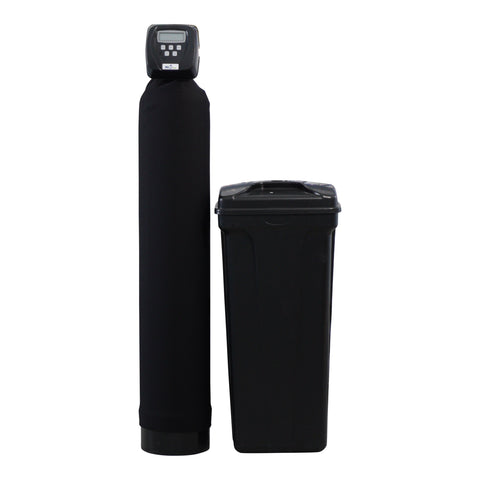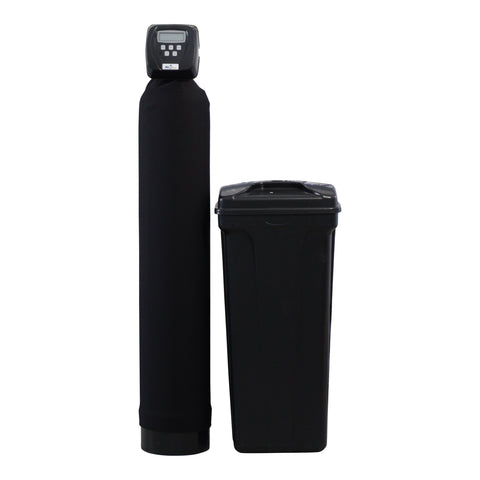
At Water eStore, we simplify water filtration to help you conquer your water woes! Whether you're a first-time DIYer, plumber, or water filtration specialist, this blog post is for you. Today, we'll be diving into the fascinating world of water softener brine tanks and unravelling the mystery behind how they actually work.
Have you ever wondered about that lone tube going into the tank and what that fitting on the outside is for? And why does the water level in the tank sometimes vary? Well, get ready because we're about to demystify it all and provide you with the answers you've been seeking. So, without further ado, let's jump right in!
GETTING STARTED
It will be easier for you to understand the water softener brine tank if you know how a water softener works. In case you don’t know about water softeners, cheque out my YouTube video here!
PARTS OF A WATER SOFTENER
TWO-PIECE WATER SOFTENERS:
When you look at the parts of a water softener, the brine tank is where the salt is stored. If you have a two-piece water softener, like our
HUM Water Care Clack valved water softener, the brine is in a separate tank.

ONE-PIECE WATER SOFTENERS:
But if you have a one-piece water softener like this WaterBoss, the media tank is inside the brine tank — but they work the same!

Brine tanks consist of these components:
- Tank or reservoir to hold the salt and water
- Brine well to keep the float separate from the salt
- Brine float to add water and remove brine from the tank, as well as shut off water coming from the water softener in case something malfunctions.
- Overflow fitting can be connected to a drain in case the float ever malfunctions or the tank overfills
- Tubing to connect the brine tank to the Water Softener valve
HOW A WATER SOFTENER WORKS

If your water softener is the post-fill kind, whenever the water softener is in service (not regenerating) there will be water in the brine tank with the salt-making brine. Pre-fill water softeners, like the kind sold at Big Box Stores, have almost no water in the cabinet when in service. So it’s normal to not see any water in there until the regeneration cycle begins.
This video explains the difference between pre and post-fill softeners. >> WATCH NOW
Basically, the brine tank holds the salt and water to make brine. If yours is a post-fill water softener, the brine has already been made and once the regeneration cycle has completed the backwash cycle, the valve switches to brine (or brine draw). This creates suction to draw all of the brine out of the brine tank. How does it do this? There is an injector with a Venturi inside which creates the suction (like in a carburetor) as water passes through to the drain.
Once the brine is gone and the media has been regenerated, a pre-determined amount of water flows into the brine tank to absorb the salt to make brine for the next cycle. The float does not determine how much water is in the brine tank, only the limit of water. If the water softener were to malfunction and not shut off the flow of water to the brine tank, the float would automatically shut off the water before it reaches the overflow.
A couple of things to keep in mind:
-
Water Softener Efficiency — High-Efficiency water softeners, like
AquaMaster and
WaterBoss water softeners, use very little salt per regeneration, so you will find very little water in the brine tank which is why the cabinet is so small.
-
Water Softener Settings — Your system's settings for the quantity of salt used per regeneration ultimately determine the water level.
Hardness and capacity settings make sure your water is soft without wasting salt and water during the regeneration. If you're unsure what settings your Water Softener should be at, have your raw water tested for hardness, iron and manganese and put those settings into your water softener.
From there your water softener will determine how much salt you need and then add the appropriate amount of water!
For example, one gallon of water absorbs 3 lbs of salt. So if your water softener uses 9 lbs per regeneration, the valve will pour 3 gallons of water in with the salt to make brine containing 9 lbs of salt.
-
Water Softener Troubleshooting — If suddenly you have significantly more water in your brine tank than normal, your water softener is malfunctioning and you better cheque out my
Water Softener Troubleshooting video here.

As you can see from the above, brine tanks are NOT just somewhere to store your salt! The operation of the brine tank is key to softening your water.
Hope today's blog has helped explain how a water softener brine tank works in more detail and answered all your brine tank questions. If you do need further help, however, don't hesitate to reach out to us via the contact section of our website!










